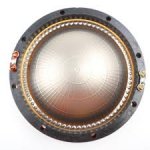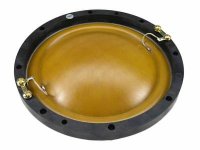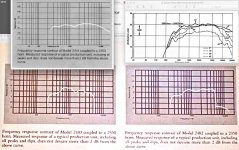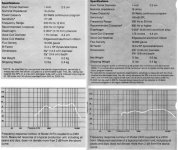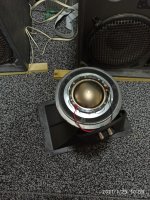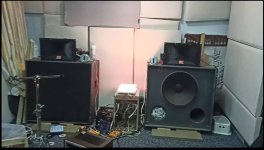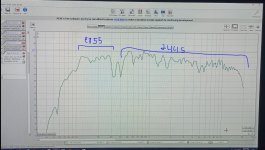hi,
want to lower the frequency response for this compression driver, from 600hz to 300hz.
i realize that if i replace the Diaphragm from titanium to phenolic Diaphragm i achieve this goal?
the JBL 2482 has low frequency Diaphragm, it is fit?
thanks
want to lower the frequency response for this compression driver, from 600hz to 300hz.
i realize that if i replace the Diaphragm from titanium to phenolic Diaphragm i achieve this goal?
the JBL 2482 has low frequency Diaphragm, it is fit?
thanks
Attachments
Last edited:
The JBL phenolic (low frequency) diaphragm for the JBL 2480 or 2482 does not fit into the 2445. The mounting screw circle is larger on the phenolic drivers.
Barry.
Barry.
maybe i can glue the circle? the diaphragm itself is fit into the 2445?The JBL phenolic (low frequency) diaphragm for the JBL 2480 or 2482 does not fit into the 2445. The mounting screw circle is larger on the phenolic drivers.
Barry.
there is phenolic diaphragm for the 2445 Somewhere?
message i found from djk
You can make the 2482 diaphragm work in your 2440/41 structure.
Take the aluminum ring off the dead diaphragm and bolt it to the 2482 diaphragm. Re-drill the dowel pin holes. It will now fit, but drop like a rock above 5Khz (like a 2482).
The 2482 top plate is basically the same as the 2440/2441, but the dowel pins are spaced differently.
The reverse is also true, you can use a 2440/41/45 diaphragm in a 2482 by re-drilling the dowel pin holes (using the dead 2482 diaphragm clamp ring).
The top plate is minutely thicker on the 2482, so it does not have quite the flux density that the 2440/41 structure has (1.7T vs 20.5T).
Last edited:
Erez1012,hi,
want to lower the frequency response for this compression driver, from 600hz to 300hz.
i realize that if i replace the Diaphragm from titanium to phenolic Diaphragm i achieve this goal?
The low frequency response of the driver/horn combination will largely be determined by the horn- the 2482 and 2445 low frequency response is similar on the same horn, as can be seen below, both drivers roll off around 5dB between 700 and 300 Hz.
That said, the 2482 diaphragm to phase plug spacing (DPPS) is likely double that of the 2445, allowing for twice the excursion, about 6 dB more potential output down low before the diaphragm contacts the phase plug, accompanied also by an acoustical roll-off at 5kHz.
I'll never forget the sound of eight 2440 diaphragms hammering themselves to small bits during one show in 1978, while four 2482s survived with the same power at 500 Hz.
The specifications of the 1" exit aluminum 2420 compared to the phenolic 2470, both using identical motors is also informative- the lower power rating of the 2420 is further reduced when used below 800 Hz. Shattered lots of 2420 too, though replacing them with the titanium 2425 diaphragms solved that problem.
If you put a spacer shim of approximately 0.5 to 1mm between your present diaphragm and the magnet structure, the 2445 driver's low frequency output will be power (voltage), rather than excursion limited. It will also loose high frequency output, the larger the DPPS, the lower the roll off. The larger DPPS will also slightly reduce flux density (Bl, magnetic strength), slightly reducing sensitivity. Spacers can be made from paper or plastic sheet material.
Make sure to thoroughly clean the magnetic gaps, and properly align the diaphragm(s) if you decide to do any changes.
Art
Attachments
Last edited:
Art, Thank you so much for the information, very helpful to me.
I've been trying for more than two weeks to push the 2445 + 2380A to the limit, why?
its too harsh, I tried a lot of crossovers design with XSIM.
Yesterday I tried to cut in 500hz with 12db/dec. still harsh, But when I changed to one order 6db/dec(cap+zobel+lpad), the horn stop to harsh and become more warm 🙂 ( i use 15db amplifier)
I think I will try to make your experiment, I will post the changes here.If you put a spacer shim of approximately 0.5 to 1mm between your present diaphragm and the magnet structure, the 2445 driver's low frequency output will be power (voltage), rather than excursion limited. It will also loose high frequency output, the larger the DPPS, the lower the roll off. The larger DPPS will also slightly reduce flux density (Bl, magnetic strength), slightly reducing sensitivity. Spacers can be made from paper or plastic sheet material.
I've been trying for more than two weeks to push the 2445 + 2380A to the limit, why?
its too harsh, I tried a lot of crossovers design with XSIM.
Yesterday I tried to cut in 500hz with 12db/dec. still harsh, But when I changed to one order 6db/dec(cap+zobel+lpad), the horn stop to harsh and become more warm 🙂 ( i use 15db amplifier)
Attachments
Erez1012,I think I will try to make your experiment, I will post the changes here.
I've been trying for more than two weeks to push the 2445 + 2380A to the limit, why?
its too harsh, I tried a lot of crossovers design with XSIM.
Not sure what you mean by "push the 2445 + 2380A to the limit, why?" but increasing the DPPS will require tweeters, and another crossover redesign.
As it stands, if your sim is any indication of what's actually coming out of the speaker, you may simply be finding the wide overlap of the acoustic crossover of three drivers (two woofers and 2380/2445) to be causing such gross comb filtering as to sound "harsh".
Another of the old stories- built ten dual 15" 2380/2445 floor monitors- after a summer season of trying to equalize them, always resulting in crap sound and/or feedback in the crossover region (500-800Hz), ended up dropping one 15" from each cabinet and cutting the cabinet down, ended all the problems.
If you do want to use both woofers, I'd suggest a steeper crossover, less overlap, and rolling off one of the woofers an octave or two below the main acoustic crossover point. This is sometimes called a "2.5 way" crossover, both woofers full output in the bottom octaves, but only one woofer operating full output in the acoustic crossover range.
Art
i want to lower the crossover point. I'll tell you why but do not laugh at me🙂.Not sure what you mean by "push the 2445 + 2380A to the limit, why?" but increasing the DPPS will require tweeters, and another crossover redesign.
I read that the klipsch la scala cut the horn at ~ 300hz,
Maybe I'm wrong but the sound of the guitar sounds deep and I hope it's thanks to the horn
I enjoyed the story!Another of the old stories- built ten dual 15" 2380/2445 floor monitors- after a summer season of trying to equalize them, always resulting in crap sound and/or feedback in the crossover region (500-800Hz), ended up dropping one 15" from each cabinet and cutting the cabinet down, ended all the problems.
The Klipsch La Scala stock mid crossover point is around 400 Hz, in the video you linked you can hear that when the camera is on axis or above the horn.
Guitar "depth" is primarily from the reverb, the low E string of a guitar is 81Hz.
The exponential Klipsch mid horn has a lower cut-off frequency than the 2380, which drops like a rock below 500Hz.
Also, using the stock passive crossover, the Klipsch mid/high horn output arrives several milliseconds before the folded bass horn output, adding to it's "presence", also known as the precedence or "Haas effect". Since the HF horn's output arrives before the bass horn, our hearing localizes to that place. What we hear first sounds louder, even if it's not ;^).
Another story: Before being able to afford JBL horns and drivers, one summer bought Klipsch mid horn copies made from a two part liquid expanding rigid urethane plastic.
Unfortunately, when stored and transported in the cold Minnesota winters, the material would crack if subjected to the smallest bump.
All the king's horses and all the king's men
couldn't put the Humpty Dumpty K-horns together again.
Art
Guitar "depth" is primarily from the reverb, the low E string of a guitar is 81Hz.
The exponential Klipsch mid horn has a lower cut-off frequency than the 2380, which drops like a rock below 500Hz.
Also, using the stock passive crossover, the Klipsch mid/high horn output arrives several milliseconds before the folded bass horn output, adding to it's "presence", also known as the precedence or "Haas effect". Since the HF horn's output arrives before the bass horn, our hearing localizes to that place. What we hear first sounds louder, even if it's not ;^).
Another story: Before being able to afford JBL horns and drivers, one summer bought Klipsch mid horn copies made from a two part liquid expanding rigid urethane plastic.
Unfortunately, when stored and transported in the cold Minnesota winters, the material would crack if subjected to the smallest bump.
All the king's horses and all the king's men
couldn't put the Humpty Dumpty K-horns together again.
Art
Last edited:
thanks Art,
Maybe one day I will build a simple horn myself.
Your analysis about the Klipsch La Scala is excellent.
Last night I tried 3 types of crossovers, it seems to me that i have to go the bi amp direction, otherwise I have to lower the 2445 horn by 20 dB, and I'm not sure it's recommended.
the e155 has big bump till 300hz, then go plat about 1.5khz (It can not be seen in the attached image)
Maybe one day I will build a simple horn myself.
Your analysis about the Klipsch La Scala is excellent.
I can see small crack in my 2380 as well, at the first opportunity I will paste them.All the king's horses and all the king's men
couldn't put the Humpty Dumpty K-horns together again.
Last night I tried 3 types of crossovers, it seems to me that i have to go the bi amp direction, otherwise I have to lower the 2445 horn by 20 dB, and I'm not sure it's recommended.
the e155 has big bump till 300hz, then go plat about 1.5khz (It can not be seen in the attached image)
Attachments
Last edited:
- Home
- Loudspeakers
- Multi-Way
- JBL 2445j low frequency Diaphragm?
